文博信息
缅甸历史文化遗产震后速报 | 辛比梅佛塔
摘要: 缅甸历史文化遗产震后速报 | 辛比梅佛塔原创亚洲遗产管理学会亚洲遗产管理学会2025年04月05日 21:17江苏Express News缅甸历史文化遗产震后速报引言 | Foreword2025年3月28日发生的7.9级强震致使缅甸遭遇重大损失,据央视新闻与新华社最新通报,截至4月5日,缅甸28日发生的强震已造成3301人遇难,另有4792人受伤,约221人失踪,我们向所有遇难者致以沉痛的 ...
缅甸历史文化遗产震后速报 | 辛比梅佛塔原创 亚洲遗产管理学会 亚洲遗产管理学会 2025年04月05日 21:17 江苏
Express News
缅甸历史文化遗产震后速报
引言 | Foreword
2025年3月28日发生的7.9级强震致使缅甸遭遇重大损失,据央视新闻与新华社最新通报,截至4月5日,缅甸28日发生的强震已造成3301人遇难,另有4792人受伤,约221人失踪,我们向所有遇难者致以沉痛的哀悼。地震也对缅甸曼德勒-实皆-内比都沿线众多的文化遗产造成了毁灭性打击,约有150座寺庙和宝塔损毁,曼德勒皇宫、马哈牟尼佛寺、梅努寺、阿瓦大桥等重要建筑损毁严重或变为废墟。数百座佛塔、寺庙坍塌,人类共同文化遗产存续正面临严峻考验。
为此,亚洲遗产管理学会特发布系列“缅甸历史文化遗产震后速报”,呼吁全球社会关注缅甸历史文化遗产的珍贵价值及震后损毁情况,共同守护人类文明的瑰宝。
04
辛比梅佛塔震后速报
Post-earthquake Express News of
Hsinbyume Pagoda
“
01 遗产概况
辛比梅佛塔(Hsinbyume Pagoda, ဆင်ဖြူမယ်စေတီ),又名妙登佛塔(Mya Thein Tan Pagoda),译意为白象佛塔。位于缅甸实皆省敏贡古城,伊洛瓦底江西岸,距曼德勒城区西北约10公里。
这座佛塔见证了巴格达王子和他的妻子辛比梅公主(1789-1812)的爱情故事。辛比梅公主不幸在分娩时去世,巴格达王子悲痛欲绝,于 1816 年修建了辛比梅佛塔以纪念他的妻子。原塔于1839年阿瓦地震中受到严重破坏,现存的佛塔是1874年由缅甸敏东国王仿旧塔型式重建的修复塔。
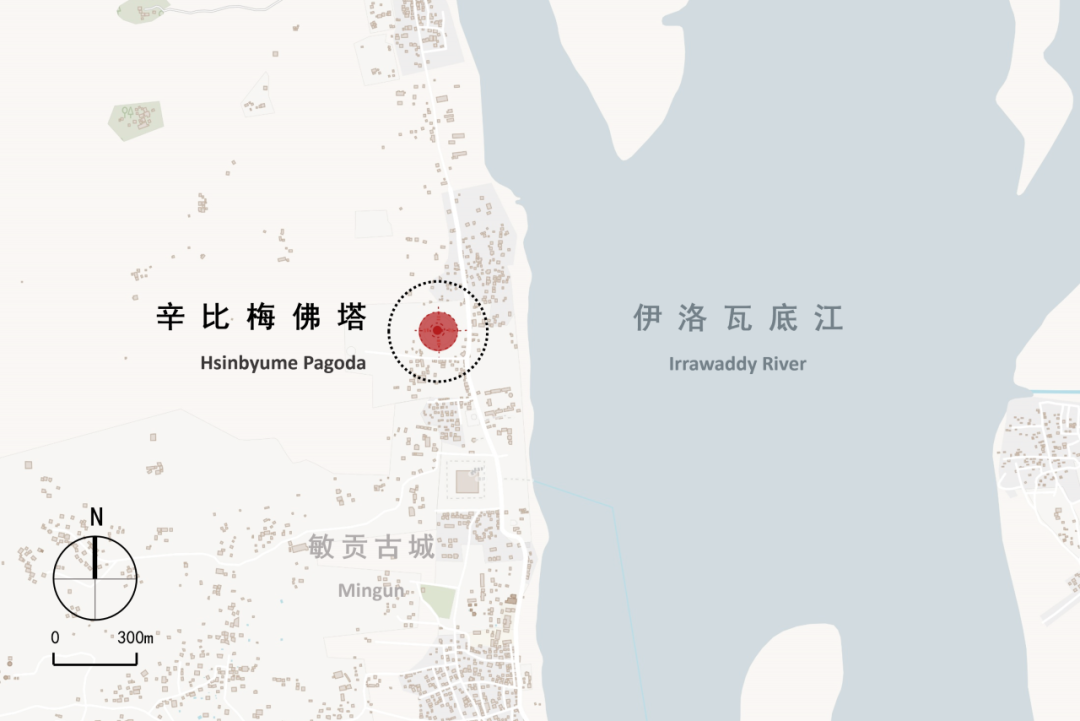
图1 辛比梅佛塔区位示意图(来源:东南大学团队自绘)
Figure 1. Location of Hsinbyume Pagoda (Source: Southeast University)
“
02 建筑特色
辛比梅佛塔的建筑样式与缅甸传统佛塔差异甚大,佛塔通体呈纯净的奶白色,模仿佛教中代表宇宙中心的须弥山形式建造,主体由中央主塔与环绕其外的七层露台组成。中央主塔兼具须弥山山体与山顶苏拉玛尼佛塔(Sulamani Pagoda)的双重象征,在中央的高塔里供奉著释迦牟尼佛,表示对佛陀的至高崇敬。佛塔的下部周围的七个同心圆波浪形露台代表环绕须弥山的七重香海与七金山。其东侧的三重阶梯呼应三十三天传说,阶梯顶端的小室供奉佛陀坐像,暗喻佛陀在三十三天说法的盘荼迦岩。
虽然佛塔的规模不是很大,但由于纯白的外表、波浪的露台与层次井然的结构,使佛塔显得格外的优雅庄重。它不仅是佛教宇宙观的物质载体,也是缅甸王室爱情的永恒见证,成为缅甸近代宗教建筑中兼具文化深度与艺术感染力的典范之作。
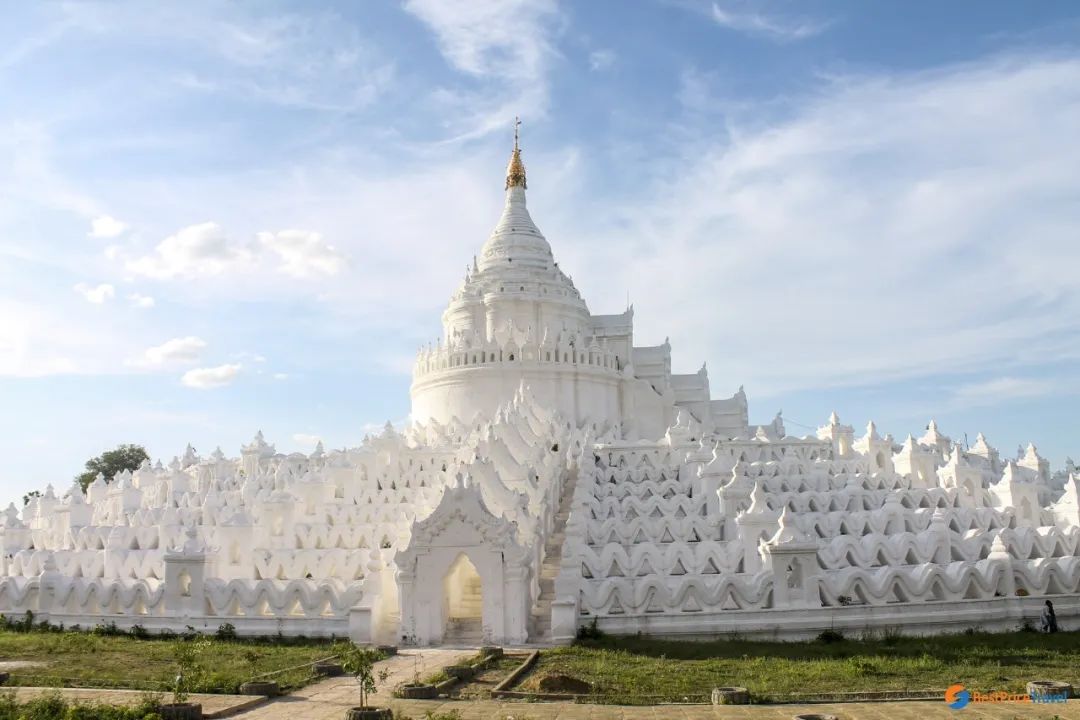
图2 辛比梅佛塔震前照片 (来源:BestPrice Travel)
Figure 2. Photo before earthquake (Source: BestPrice Travel)
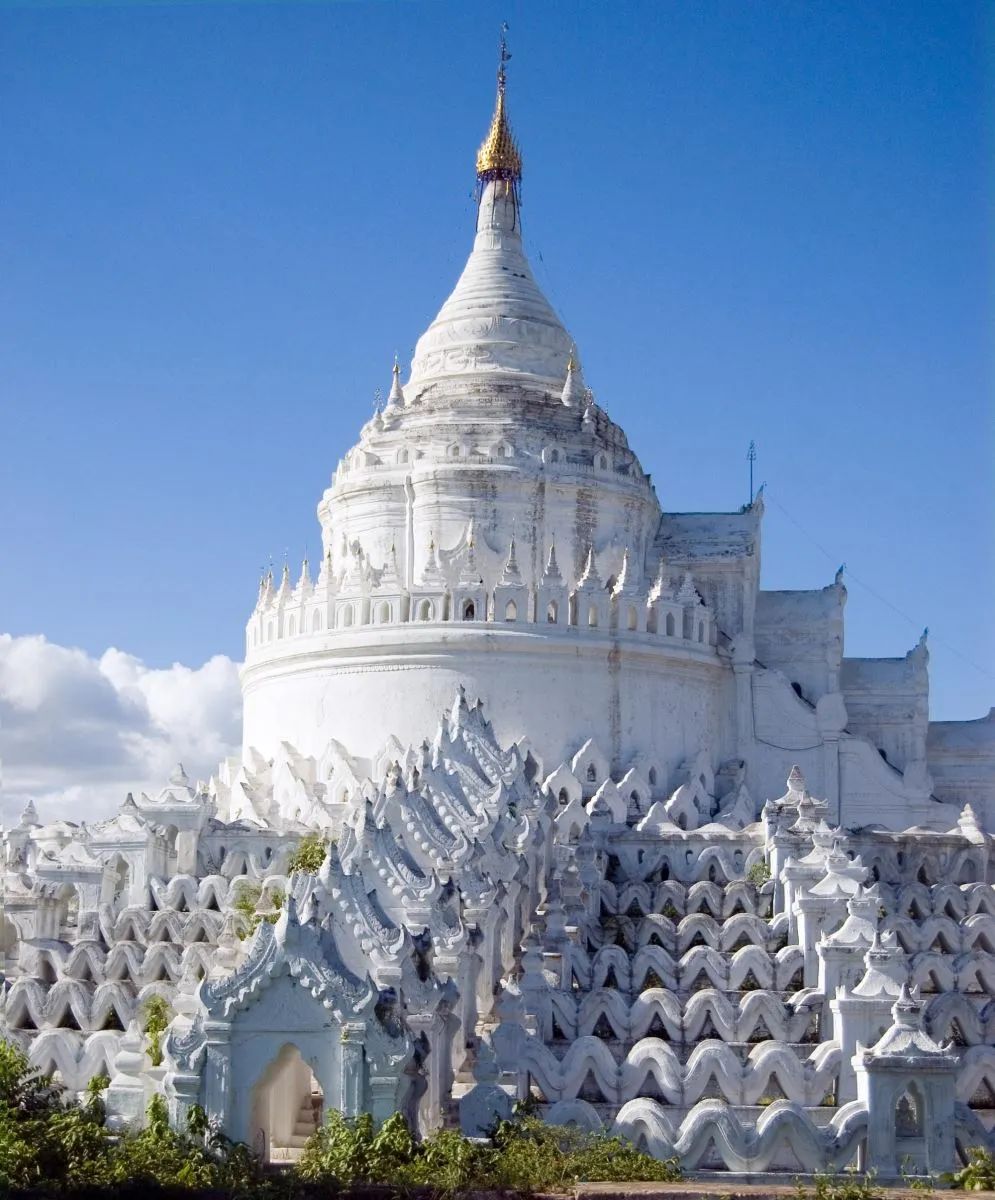
图3 辛比梅佛塔震前照片 (来源:Worldkings)
Figure 3. Photo before earthquake (Source: Worldkings)
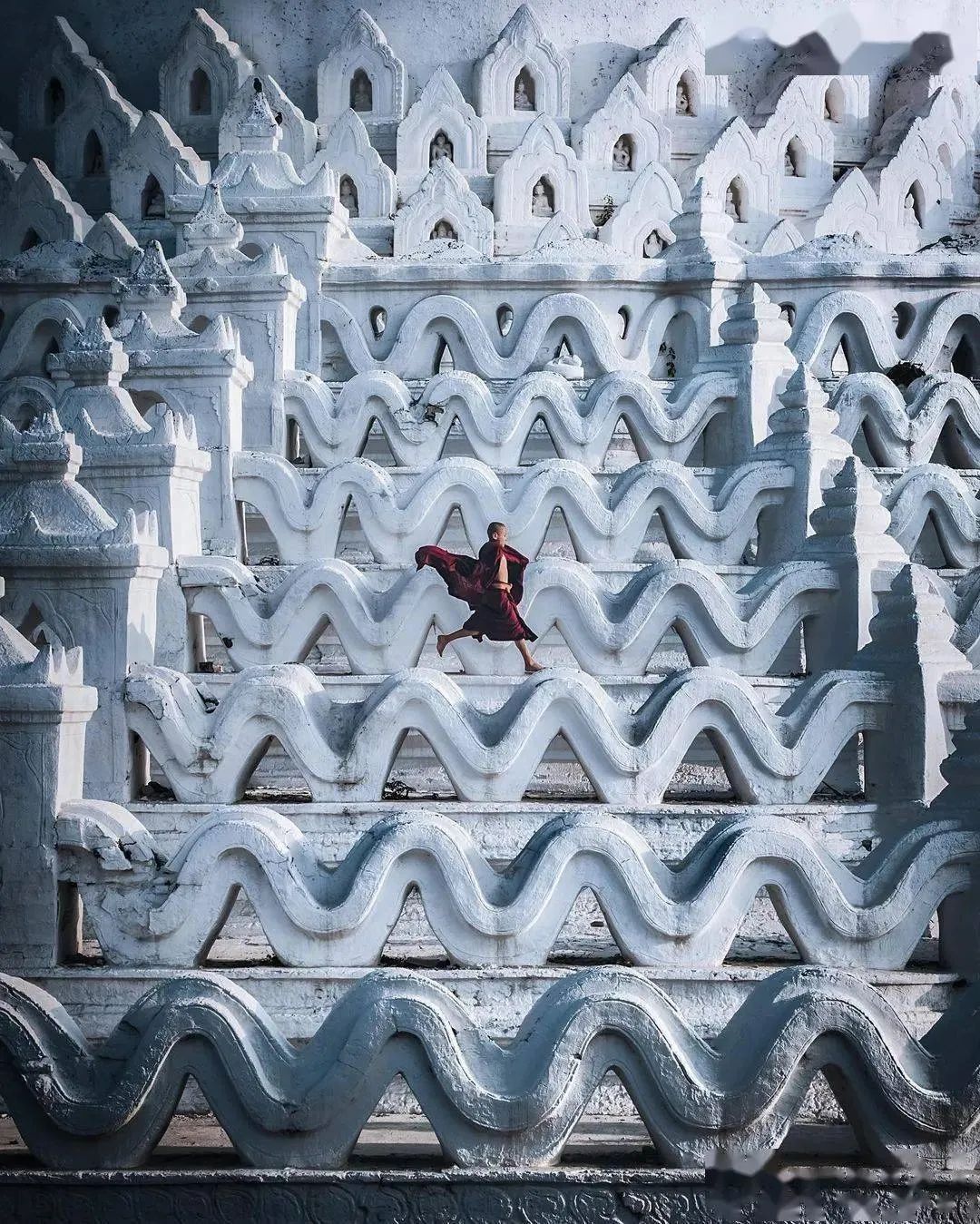
图4 辛比梅佛塔震前照片 (来源:Jord Hammond)
Figure 4. Photo before earthquake (Source: Jord Hammond)
“
03 损毁情况
据越南快讯(VnExpress)报道,地震对辛比梅佛塔造成严重的结构性损伤,中心主塔受损尤为严重,整体发生明显塌陷并出现裂缝,原本精美的塔顶几乎完全坍塌,红色砖石大量脱落,并散落在白色露台之上,而露台本身也出现了开裂和局部脱落的现象。
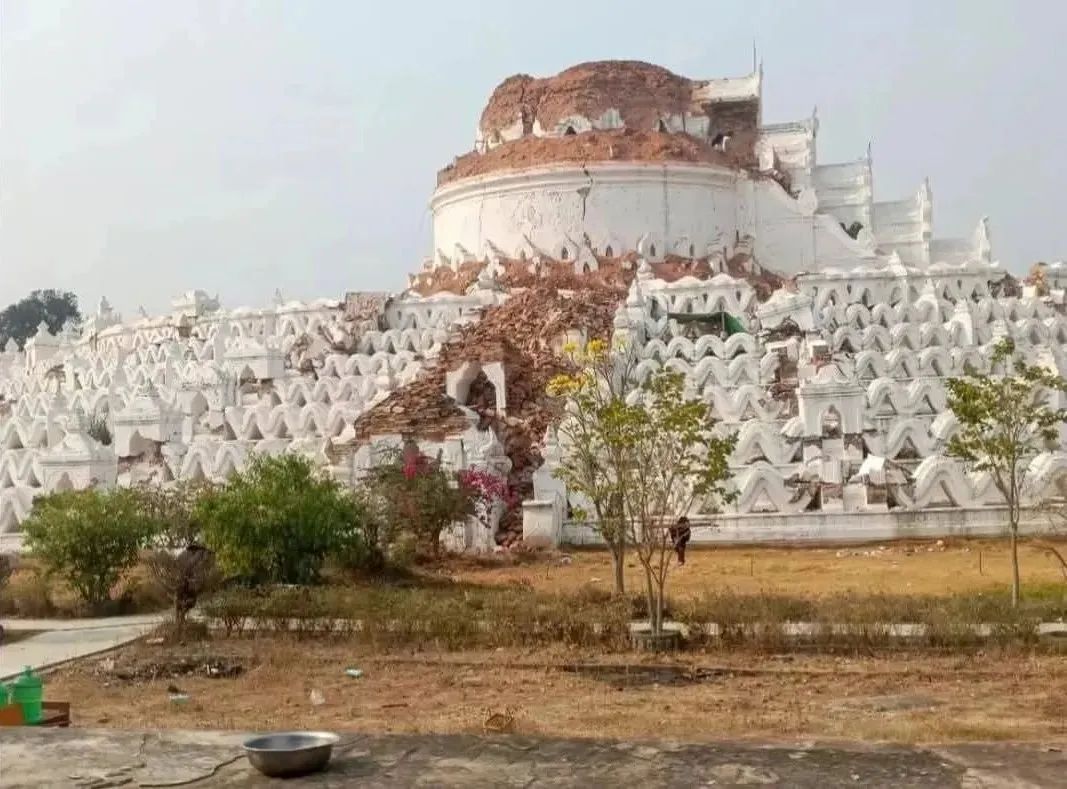
图5 辛比梅佛塔震后照片 (来源:缅甸当地群众拍摄)
Figure 5. Photo after earthquake (Source: Photo from Local people in Myanma)
The following is the English version:
Express News
Post-earthquake Express News on Myanmar's Historical and Cultural Heritages
Foreword
The 7.9-magnitude earthquake that struck on March 28, 2025 caused heavy losses to Myanmar. According to latest reports from CCTV NEWS and the Xinhua News Agency, as of April 5th, the strong earthquake that struck Myanmar on the 28th has resulted in 3301 deaths, with another 4729 injured and approximately 221 missing. We extend our deepest condolences to all the victims.
The earthquake also dealt a devastating blow to numerous cultural heritage sites along Mandalay - Sagaing - Naypyitaw region, with about 150 temples and pagodas damaged. Important structures such as the King Palace, Mahamuni Pagoda, Me Nu Oak Kyaung, Innwa Bridge have suffered severe damage or been reduced to ruins. Hundreds of stupas and temples collapsed. The survival of the common cultural heritages of mankind is facing a severe test.
To this end, the Asian Academy for Heritage Management has released a series of "Post-earthquake Express News on Myanmar's Historical and Cultural Heritages", calling on the global community to pay attention to the precious value of Myanmar's historical and cultural heritages and the damages condition after the earthquake, and jointly protect the treasures of human civilization.
04
Post-earthquake Express News of Hsinbyume Pagoda
“
01 Heritage Overview
Hsinbyume Pagoda(Burmese:ဆင်ဖြူမယ်စေတီ), also known as Myatheindan Pagoda, is located in Mingun, an ancient town in Sagaing Region, Myanmar. It sits on the western bank of the Irrawaddy River, about 10 kilometers northwest of Mandalay. Renowned for its pristine white appearance and its tiered, cream-like decorative design, it is affectionately nicknamed the “White Wedding Cake Pagoda.”
The pagoda stands as a testament to the love story between Prince Bagyidaw and his wife, Princess Hsinbyume (1789–1812). Tragically, Princess Hsinbyume died during childbirth. Heartbroken, Prince Bagyidaw commissioned the construction of the Hsinbyume Pagoda in 1816 to honor her memory. The original structure suffered significant damage during the Ava earthquake of 1839. The current pagoda is a restored version, rebuilt in 1874 by King Mindon of Burma, modeled after the original design.
“
02 Architectural Features
The architectural style of Hsinbyume Pagoda differs significantly from traditional Burmese pagodas. The entire structure is a pure, creamy white, and it is modeled after Mount Meru, the mythological center of the universe in Buddhist cosmology. The main structure consists of a central stupa surrounded by seven concentric, wavy terraces, symbolizing the mountain’s cosmic significance.
The central stupa serves as a dual symbol of Mount Meru and the Sulamani Pagoda at its summit. Inside the central tower, a statue of Shakyamuni Buddha is enshrined, reflecting the profound reverence for the Buddha. The seven wavy terraces encircling the lower part of the pagoda represent the seven seas and seven golden mountain ranges that are believed to surround Mount Meru.
On the eastern side, a triple stairway symbolizes the legend of the Tāvatiṃsa Heaven, or the Heaven of the Thirty-Three Gods. At the top of the staircase, a small chamber houses a seated Buddha image, alluding to Buddha preaching atop the Mount of Pāṇḍukambala Rock in the Tāvatiṃsa Heaven.
Although modest in scale, Hsinbyume Pagoda stands out for its elegant purity, flowing wave-like curves, and harmonious tiers. It is not only a physical embodiment of the Buddhist cosmological worldview but also an eternal monument to royal love. As such, it has become a masterpiece of modern Burmese religious architecture, distinguished by both its philosophical depth and artistic grace.
“
03 Damages Condition
According to VnExpress, the earthquake caused severe structural damage to the Hsinbyume Pagoda, with the central stupa and the spire being particularly affected. A photo shows that the main stupa of the pagoda suffered a significant collapse and visible cracks. The once exquisite spire has almost completely crumbled, with a large amount of red bricks scattered across the white terrace. The terrace itself has also developed cracks and shows signs of partial detachment.
END
图片来源:亚洲遗产管理学会
文字来源:亚洲遗产管理学会
学术支持:城市与建筑遗产保护教育部重点实验室(东南大学)
中国城市规划学会城市规划历史与理论分会
制作:伍若萱、May Myat Noe Ko(缅)
审核:汪艳
审定:董卫、江泓

扫码关注
亚洲遗产管理学会
Asian Academy for
Heritage Management
Express News
缅甸历史文化遗产震后速报
引言 | Foreword
2025年3月28日发生的7.9级强震致使缅甸遭遇重大损失,据央视新闻与新华社最新通报,截至4月5日,缅甸28日发生的强震已造成3301人遇难,另有4792人受伤,约221人失踪,我们向所有遇难者致以沉痛的哀悼。地震也对缅甸曼德勒-实皆-内比都沿线众多的文化遗产造成了毁灭性打击,约有150座寺庙和宝塔损毁,曼德勒皇宫、马哈牟尼佛寺、梅努寺、阿瓦大桥等重要建筑损毁严重或变为废墟。数百座佛塔、寺庙坍塌,人类共同文化遗产存续正面临严峻考验。
为此,亚洲遗产管理学会特发布系列“缅甸历史文化遗产震后速报”,呼吁全球社会关注缅甸历史文化遗产的珍贵价值及震后损毁情况,共同守护人类文明的瑰宝。
04
辛比梅佛塔震后速报
Post-earthquake Express News of
Hsinbyume Pagoda
“
01 遗产概况
辛比梅佛塔(Hsinbyume Pagoda, ဆင်ဖြူမယ်စေတီ),又名妙登佛塔(Mya Thein Tan Pagoda),译意为白象佛塔。位于缅甸实皆省敏贡古城,伊洛瓦底江西岸,距曼德勒城区西北约10公里。
这座佛塔见证了巴格达王子和他的妻子辛比梅公主(1789-1812)的爱情故事。辛比梅公主不幸在分娩时去世,巴格达王子悲痛欲绝,于 1816 年修建了辛比梅佛塔以纪念他的妻子。原塔于1839年阿瓦地震中受到严重破坏,现存的佛塔是1874年由缅甸敏东国王仿旧塔型式重建的修复塔。

图1 辛比梅佛塔区位示意图(来源:东南大学团队自绘)
Figure 1. Location of Hsinbyume Pagoda (Source: Southeast University)
“
02 建筑特色
辛比梅佛塔的建筑样式与缅甸传统佛塔差异甚大,佛塔通体呈纯净的奶白色,模仿佛教中代表宇宙中心的须弥山形式建造,主体由中央主塔与环绕其外的七层露台组成。中央主塔兼具须弥山山体与山顶苏拉玛尼佛塔(Sulamani Pagoda)的双重象征,在中央的高塔里供奉著释迦牟尼佛,表示对佛陀的至高崇敬。佛塔的下部周围的七个同心圆波浪形露台代表环绕须弥山的七重香海与七金山。其东侧的三重阶梯呼应三十三天传说,阶梯顶端的小室供奉佛陀坐像,暗喻佛陀在三十三天说法的盘荼迦岩。
虽然佛塔的规模不是很大,但由于纯白的外表、波浪的露台与层次井然的结构,使佛塔显得格外的优雅庄重。它不仅是佛教宇宙观的物质载体,也是缅甸王室爱情的永恒见证,成为缅甸近代宗教建筑中兼具文化深度与艺术感染力的典范之作。

图2 辛比梅佛塔震前照片 (来源:BestPrice Travel)
Figure 2. Photo before earthquake (Source: BestPrice Travel)

图3 辛比梅佛塔震前照片 (来源:Worldkings)
Figure 3. Photo before earthquake (Source: Worldkings)

图4 辛比梅佛塔震前照片 (来源:Jord Hammond)
Figure 4. Photo before earthquake (Source: Jord Hammond)
“
03 损毁情况
据越南快讯(VnExpress)报道,地震对辛比梅佛塔造成严重的结构性损伤,中心主塔受损尤为严重,整体发生明显塌陷并出现裂缝,原本精美的塔顶几乎完全坍塌,红色砖石大量脱落,并散落在白色露台之上,而露台本身也出现了开裂和局部脱落的现象。

图5 辛比梅佛塔震后照片 (来源:缅甸当地群众拍摄)
Figure 5. Photo after earthquake (Source: Photo from Local people in Myanma)
The following is the English version:
Express News
Post-earthquake Express News on Myanmar's Historical and Cultural Heritages
Foreword
The 7.9-magnitude earthquake that struck on March 28, 2025 caused heavy losses to Myanmar. According to latest reports from CCTV NEWS and the Xinhua News Agency, as of April 5th, the strong earthquake that struck Myanmar on the 28th has resulted in 3301 deaths, with another 4729 injured and approximately 221 missing. We extend our deepest condolences to all the victims.
The earthquake also dealt a devastating blow to numerous cultural heritage sites along Mandalay - Sagaing - Naypyitaw region, with about 150 temples and pagodas damaged. Important structures such as the King Palace, Mahamuni Pagoda, Me Nu Oak Kyaung, Innwa Bridge have suffered severe damage or been reduced to ruins. Hundreds of stupas and temples collapsed. The survival of the common cultural heritages of mankind is facing a severe test.
To this end, the Asian Academy for Heritage Management has released a series of "Post-earthquake Express News on Myanmar's Historical and Cultural Heritages", calling on the global community to pay attention to the precious value of Myanmar's historical and cultural heritages and the damages condition after the earthquake, and jointly protect the treasures of human civilization.
04
Post-earthquake Express News of Hsinbyume Pagoda
“
01 Heritage Overview
Hsinbyume Pagoda(Burmese:ဆင်ဖြူမယ်စေတီ), also known as Myatheindan Pagoda, is located in Mingun, an ancient town in Sagaing Region, Myanmar. It sits on the western bank of the Irrawaddy River, about 10 kilometers northwest of Mandalay. Renowned for its pristine white appearance and its tiered, cream-like decorative design, it is affectionately nicknamed the “White Wedding Cake Pagoda.”
The pagoda stands as a testament to the love story between Prince Bagyidaw and his wife, Princess Hsinbyume (1789–1812). Tragically, Princess Hsinbyume died during childbirth. Heartbroken, Prince Bagyidaw commissioned the construction of the Hsinbyume Pagoda in 1816 to honor her memory. The original structure suffered significant damage during the Ava earthquake of 1839. The current pagoda is a restored version, rebuilt in 1874 by King Mindon of Burma, modeled after the original design.
“
02 Architectural Features
The architectural style of Hsinbyume Pagoda differs significantly from traditional Burmese pagodas. The entire structure is a pure, creamy white, and it is modeled after Mount Meru, the mythological center of the universe in Buddhist cosmology. The main structure consists of a central stupa surrounded by seven concentric, wavy terraces, symbolizing the mountain’s cosmic significance.
The central stupa serves as a dual symbol of Mount Meru and the Sulamani Pagoda at its summit. Inside the central tower, a statue of Shakyamuni Buddha is enshrined, reflecting the profound reverence for the Buddha. The seven wavy terraces encircling the lower part of the pagoda represent the seven seas and seven golden mountain ranges that are believed to surround Mount Meru.
On the eastern side, a triple stairway symbolizes the legend of the Tāvatiṃsa Heaven, or the Heaven of the Thirty-Three Gods. At the top of the staircase, a small chamber houses a seated Buddha image, alluding to Buddha preaching atop the Mount of Pāṇḍukambala Rock in the Tāvatiṃsa Heaven.
Although modest in scale, Hsinbyume Pagoda stands out for its elegant purity, flowing wave-like curves, and harmonious tiers. It is not only a physical embodiment of the Buddhist cosmological worldview but also an eternal monument to royal love. As such, it has become a masterpiece of modern Burmese religious architecture, distinguished by both its philosophical depth and artistic grace.
“
03 Damages Condition
According to VnExpress, the earthquake caused severe structural damage to the Hsinbyume Pagoda, with the central stupa and the spire being particularly affected. A photo shows that the main stupa of the pagoda suffered a significant collapse and visible cracks. The once exquisite spire has almost completely crumbled, with a large amount of red bricks scattered across the white terrace. The terrace itself has also developed cracks and shows signs of partial detachment.
END
图片来源:亚洲遗产管理学会
文字来源:亚洲遗产管理学会
学术支持:城市与建筑遗产保护教育部重点实验室(东南大学)
中国城市规划学会城市规划历史与理论分会
制作:伍若萱、May Myat Noe Ko(缅)
审核:汪艳
审定:董卫、江泓

扫码关注
亚洲遗产管理学会
Asian Academy for
Heritage Management
